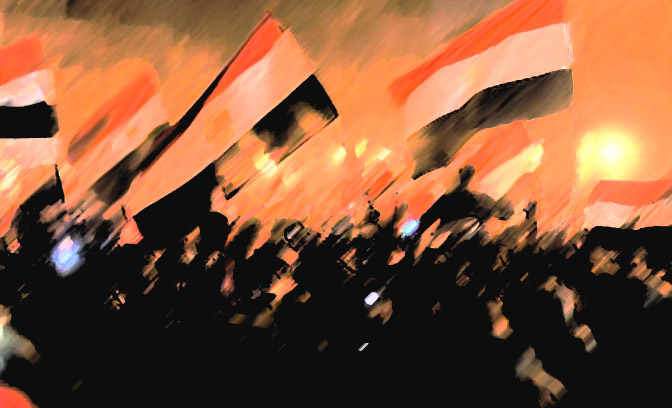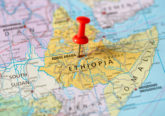Five years after Mohamed Bouazizi’s self-immolation in Sidi Bouzid, Tunisia ignited the Arab Spring. Yet while it inspired hope for democratic transition across the Middle East and North Africa, the region continues to be embroiled in civil war, terrorist networks, and crises of political legitimacy. In Syria and Bahrain, dictators used violence to thwart protests, leading to a prolonged civil war in Syria. In Yemen, despite the dictator’s negotiated transfer of power, rival sectarians are vying for power. In Tunisia and Egypt, dictators stepped down without much bloodshed. Lastly, in Libya, rebels overthrew the dictator with foreign military aid, but soon succumbed to factional warfare. This article will explore the interlude of democratic or semi-democratic politics in Tunisia, Egypt and Libya that characterized the aftermath of the wave of protests that swept the region in 2011.
Tunisia, Egypt and Libya adopted new constitutions, though Egypt’s democratic constitution was revoked by a military coup and Libya adopted two interim constitutions before political collapse. Confronting similar challenges in the post-authoritarian interim period, the framers of each constitution intended to create a new, democratic state. Existing ideological polarization, especially between secularists and Islamists, played a crucial role in determining the diversity of interests represented at the bargaining table, as well as the ultimate balance each constitution struck between government empowerment and minority rights. The drafting processes and the resulting constitutions are indicative of the vastly divergent trajectories each country has taken.
Tunisia
In Tunisia, widely hailed as the hope of the Arab Spring, protestors peacefully overthrew President Zine El Abidine Ben Ali and transitioned to democracy with free and fair general and presidential elections. Tunisia ratified a “model” constitution that enshrines gender equality, defines human rights and strikes a balance between Islamist factions and secularist concerns. The nation’s successful transition is rooted in its well-developed civil society, which intervened at a critical point during the constitutional bargaining process to reconcile the Islamist Ennahda party and more secular political factions. The four prominent civil society organizations, known as the Quartet, were awarded the Nobel peace prize in October 2015 for their role in negotiating the constitutional bargain.
The two factions compromised on a semi-presidential system with a weak president in an effort to reassure secularists concerned about being excluded from power by Ennahda-led parliamentary coalitions. Furthermore, Ennahda rejected Sharia law as the basis of national legislation, an important concession to the secular parties. The accommodation reached between the two sides was possible because Tunisia is significantly less polarized than either Egypt or Libya. The inclusion of diverse groups in the drafting process ensured that the constitution constrained state power and delineated crucial minority rights. A successful electoral transition in 2014 from Ennahda to Nidaa Tounes, an umbrella party for leftists, liberals and businessmen who oppose the Islamist faction, further consolidated political stability.
Alongside significant strides toward democratization, Tunisia continues to confront corruption and an inefficient economy that favors old elites and is hampered by an increasingly large public sector. These problems are further exacerbated by an internal political struggle for the future of Nidaa Tounes.
Tunisia further struggles to reconcile its democratic institutions with extreme pockets of Islamic radicalization among its youth. Tunisia is the largest source of foreign fighters for the Islamic State in Syria and Iraq, and increasing numbers of Tunisians are traveling to neighboring Libya to grow the Islamic State’s presence in that war-torn country. Radicalization in Tunisia has also spilled over into the West. The recent attack in Nice, which killed 84 people and injured 202 others, was carried out by a man born in Tunisia who maintained significant familial ties to his homeland.
Egypt
The Arab Spring in Egypt started in much the same way as in Tunisia, as major protests convinced Hosni Mubarak to step down after three decades in power. Similarities end there, however. The principal actor in the Egyptian transition was the national military, which has been a dominant force in Egypt since General Gamal Abdel Nasser helped lead a military coup in 1952. Since that time, the military consolidated significant social and economic power, employing over 100,000 people in the defense industry and controlling up to 40 percent of the national economy. As the essential power broker in Egyptian politics, the military cast its weight behind first the Islamists and then secularists, thereby determining the constitutional and political configuration of the state.
After Mubarak gave up power, the interim military government held parliamentary elections that yielded an Islamist supermajority comprised of the Muslim Brotherhood and the extreme Islamist (Salafist) Alliance. For much of its first year in office in 2012, it appeared that the newly ascendant Muslim Brotherhood under the leadership of Muhammad Morsi and the military’s “deep state” had reached an accommodation. Yet polarization between Islamists and those who sought to create a secular Egypt was so strong that secular and Coptic Christian parliamentarians walked out of constitutional assemblies multiple times in protest to the Islamization of the document. Despite these concerns, Morsi pushed through the Islamist constitution using a presidential decree. Egyptians responded with demonstrations similar to those that brought down Mubarak. The military again sided with protestors, leading a coup d’état against Morsi and suspending the Islamist constitution.
A new constitutional convention was convened comprised of union leaders, prominent public figures, human rights leaders, and religious leaders. Polarization again played a critical role as Islamists were largely excluded from the drafting process, despite maintaining support from at least half of the Egyptian population. The new 2014 constitution strengthened the military and the old political establishment, outlawed religious parties, and politicized the judiciary, which had intervened several times throughout the Morsi years to weaken the Islamists. The exclusion of the Islamist element from the constitutional process meant that the Egyptian constitution empowered the state to repress such dissidents.
When General Abdel-Fattah al-Sisi won the presidency in 2014, he cracked down on the Muslim Brotherhood, banning the party and imprisoning and killing its leadership and thousands of its supporters. Under the authoritarian leadership of al-Sisi, Egypt looks very similar to the pre-Arab Spring dictatorship under Mubarak. Despite investments from Gulf states, living standards remain low, while the public sector, which include vast government building projects, dominate the economy. Furthermore, Al-Sisi is struggling to tackle a growing jihadist insurgency in Sinai, though the continued conflict gives him the pretext to further consolidate power.
Libya
Finally, while Tunisia and Egypt struggle under political and economic pressures, Libya has succumbed to factional warfare. The roots of the current crisis can be traced to Libya’s historical tribal and regional divisions. Muammar Gaddafi seized power in a coup d’etat in 1969, fostering a personalisticictatorship by crushing political opposition and coopting tribal leaders. Gaddafi also undermined the military by using oil revenues to hire an army of personal guards mostly from sub-Saharan Africa. When the Arab Spring spread to Libya, Gaddafi’s armed forces had few ties to the population and thus showed little qualms in firing at demonstrators.
Gaddafi’s decision to use violence against peaceful demonstrators in Benghazi and Tripoli started a civil war in February 2011. Rebel leaders formed the National Transitional Council (NTC), comprised of a self-selected group of non-Islamists. The NTC, which promulgated a basic interim constitution, decided to subordinate Islamic politics in order to convince Western governments to intervene militarily to overthrow Gaddafi. From the beginning, however, the NTC faced opposition from Islamic political and militia forces. Their exclusionary tactics coupled with Gaddafi’s policies of undermining national institutions, meant that the NTC lacked enforcement authority and a monopoly of force to subordinate the myriad of militias that sprang up during the civil war. Islamists stormed the NTC headquarters in Benghazi, over 100 militia brigades from Misrata engaged in retributive killings of Gaddafi supporters, and ethnic tensions between Arab Islamists and minority Berber and Tebou populations led to violent clashes.
Amid the chaos, the NTC held elections to the General National Congress (GNC) in July 2012. As in Tunisia and Egypt, the GNC and the constitutional reforms it launched became a political battleground for Islamists and secularists who fought over the future of the country. The difference in Libya was that each political faction was backed by a militia willing to gain concessions at gunpoint. Islamists forcefully passed a “political isolation law,” pushing Gaddafi-era officials generally allied with more secular factions out of office. In response, secular factions under the leadership of General Khalifa Hifter launched a military assault against the GNC to force it to hold parliamentary elections. The elections, which brought secularists to power, only exacerbated divisions between Islamists and secularists. The GNC refused to give up power and entrenched itself in the west with the support of Islamic, Berber and Misratan militias, while the newly elected Parliament took up residence in the eastern city of Beidan, allied with Arab tribes and militias.
Libya is fractured between two rival parliaments, governments, courts and security forces based in Beidan and Tripoli. This division is partly explained by the exclusionary constitution-drafting process, which sought, at various times, to fend off radical Islamists, secularists, Gaddafi-era officials, secessionists, and militias. The constitutional drafts have thus empowered the repressive capacity of the state, while granting few rights to dissidents and minorities. United Nations efforts to broker a deal between the warring factions has not borne fruit, while the economic situation in the country continues to deteriorate with nearly a quarter of the nation’s foreign reserve consumed in 2014. Most worrying for the West and Libya’s neighbors is the growing strength of jihadist group, including the Islamic State, in the vacuum of power created by national divisions. Much like the intransigent conflicts battering Iraq and Syria, the situation in Libya continues to deteriorate and prospects for democracy and governance are waning.
What success looks like
The Arab Spring in Tunisia, Egypt and Libya created an opening for drafting new constitutions and redefining the state along democratic principles. Leading actors in all three countries, both secularists and Islamists, seized on this opportunity to change the political sphere. The resulting constitutional bargains and post-Arab Spring national trajectories were determined by the levels of factional polarization, and dissidents’ willingness to work together.
This article is adapted from a journal article written by Ester Cross and Jason Sorens, Dartmouth College, in Democratization journal, “Arab Spring constitution-making: polarization, exclusion, and constraints.” Published online on November 27, 2015.




